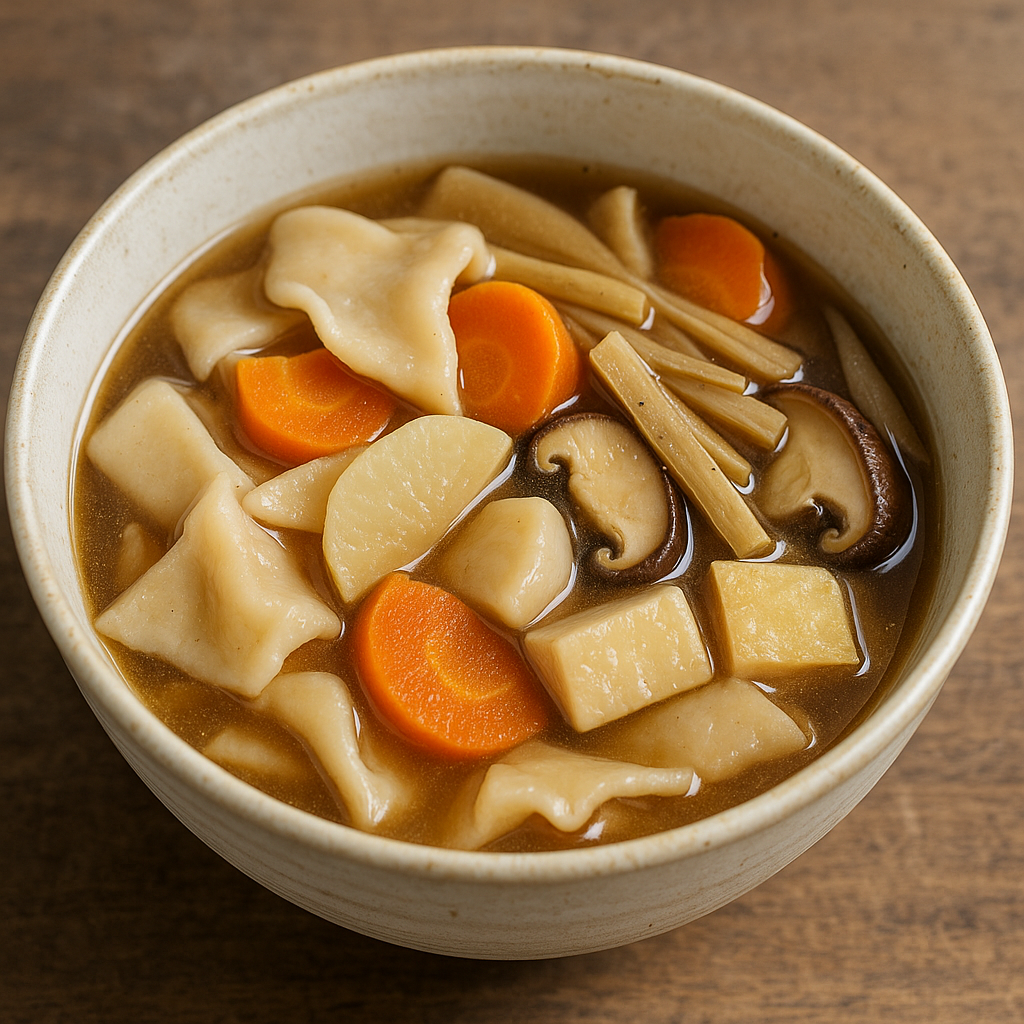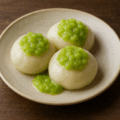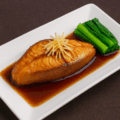はっと汁(宮城)の特徴
小麦の生地をのばしてちぎる“はっと”を、根菜たっぷりの澄ましでいただきます
はっと汁は、塩を加えた小麦粉の生地を薄くのばして手でちぎり、だしで根菜やきのこと一緒に煮る宮城の郷土料理です。つるりとしたのど越しと、もっちりした噛みごたえが、しょうゆ仕立てのだしによく合います。
のばし方・ちぎり方で食感が変わり、具材は季節で彩りが広がります
生地は寝かせてから薄くのばすほど歯切れが軽くなります。里いも・大根・ごぼう・きのこ、鶏肉や仙台麩、せりなどを合わせることが多く、家庭ごとに味わいが受け継がれています。
はっと汁(宮城) レシピ
材料(5人分)
- 薄力粉(または中力粉) … 250g
- 水 … 140〜170ml(生地の状態で加減)
- 塩 … 小さじ1/2
- だし … 1,200ml(昆布+かつお/または煮干し)
- 鶏もも肉 … 150g(小さめそぎ切り)
- 大根 … 200g(いちょう切り)
- にんじん … 120g(半月切り)
- ごぼう … 80g(ささがき・水にさらす)
- しいたけ … 40g
- タケノコ … 100g(短冊・下ゆで)
- 豆腐…1/2丁
- 油揚げ … 1枚(油抜き・短冊)または仙台麩 … 20g(戻して短冊)
- しょうゆ … 大さじ3
- みりん … 大さじ2
- 酒 … 大さじ1
- 塩 … 少々(味の締め)
- (好みで)せり … 適量(仕上げ・3〜4cm)
作り方
- 生地をこねる:ボウルで薄力粉・塩を混ぜ、水を少しずつ加えてひとまとめにする。耳たぶ程度にこね、ラップで包んで20〜30分休ませる。
- 具材準備:大根・にんじん・ごぼう・しいたけ・・油揚げ(または仙台麩)を切る。鶏肉は小さめに切る。
- だしを沸かす:鍋にだしを沸かし、鶏肉を入れてアクを引く。大根・にんじん・ごぼう・こんにゃく・きのこ・油揚げを加え、中火で8〜10分煮る。
- 調味:酒・みりん・しょうゆで味を整える。
- はっと成形:休ませた生地を手のひらで薄くのばし、親指大にちぎる(できるだけ薄く広げる)。
- 煮る:鍋を軽く沸かした状態に保ち、はっとを数回に分けて入れる。浮いてから1〜2分煮て火を通す。長ねぎ(・せり)を加えてさっと温める。
- 仕上げ:味を見て塩で微調整し、器によそう。
シェフのワンポイントアドバイス
- 生地は休ませることでのびが良くなり、薄くのばしても切れにくくなります。
- はっとは薄く・小さく・数回に分けて入れると、くっつきにくく均一に火が入ります。
- 仙台麩を使う場合は油揚げを省き、だしをやや多めにすると旨みを含んでおいしいです。
- 季節により味噌仕立ても可。しょうゆ少量を“締め”に使うと味に奥行きが出ます。
栄養価(1人分の目安)
- エネルギー … 280〜420 kcal
- たんぱく質 … 10〜16 g(鶏肉・小麦由来)
- 脂質 … 4〜9 g
- 炭水化物 … 45〜70 g(小麦・野菜由来)
- 食物繊維 … 3〜6 g(根菜・きのこ由来)
歴史
“はっと/ばっとう”に通じる小麦生地の汁ものとして広がりました
小麦粉をこねてのばし、ちぎって煮る食べ方は東北各地に伝わり、宮城でも畑の野菜と合わせた一椀として定着しました。だしと調味の違いに土地柄が表れます。
節目の集まりを支える“大鍋の味”です
彼岸や盆、作業のねぎらいなど人の集まる場で大鍋に仕立てられ、のばし方・具の取り合わせに家庭の流儀が受け継がれています。
English Version
Features of Hatto-jiru (Miyagi)
Hand-stretched, hand-torn wheat “hatto” in a clear broth with plenty of roots
Hatto-jiru is a Miyagi soup where salted wheat dough is rolled thin, torn by hand, and simmered with root vegetables and mushrooms in dashi. Its silky slurp and gentle chew pair beautifully with a soy-seasoned clear broth.
Dough thickness and tearing change the bite; seasonal add-ins broaden the palette
Resting the dough before stretching makes for a lighter bite when rolled thinner. Families often add taro, daikon, burdock, mushrooms, chicken or Sendai wheat gluten, and seri (Japanese parsley), with each home passing down its own balance.
Hatto-jiru (Miyagi) – Recipe
Ingredients (Serves 5)
- Cake or all-purpose flour … 250 g
- Water … 140–170 ml (adjust to dough)
- Salt … 1/2 tsp
- Dashi … 1,200 ml (kombu + katsuobushi, or niboshi)
- Chicken thigh … 150 g (thin slant cuts)
- Daikon … 200 g (half-moons)
- Carrot … 120 g (half-moons)
- Burdock … 80 g (shaved; briefly soaked)
- Shiitake … 40 g (sliced)
- Bamboo shoot … 100 g (batons; pre-blanched)
- Tofu … 1/2 block (batons)
- Konnyaku … 1/2 slab (batons; parboiled)
- Abura-age … 1 piece (oil-blanched; batons)
or Sendai-fu … 20 g (soaked; batons) - Long green onion … 1 stalk (diagonal slices)
- Soy sauce … 3 Tbsp
- Mirin … 2 Tbsp
- Sake … 1 Tbsp
- Salt … a pinch (to finish)
- (Optional) Seri … to taste (3–4 cm lengths)
Directions
- Make the dough: Mix flour and salt; add water gradually and knead until soft (earlobe feel). Wrap and rest 20–30 minutes.
- Prep ingredients: Cut daikon, carrot, burdock, shiitake, bamboo shoot, tofu, abura-age (or Sendai-fu). Slice chicken.
- Start the broth: Bring dashi to a boil; add chicken and skim. Add daikon, carrot, burdock, konnyaku, mushrooms, and abura-age (or Sendai-fu). Simmer 8–10 minutes over medium heat.
- Season: Add sake, mirin, and soy sauce; balance to taste.
- Form the hatto: Press the rested dough very thin with moistened hands and tear into thumb-sized pieces.
- Cook: Keep at a gentle boil; add hatto in batches. After they float, simmer 1–2 minutes. Add long onion (and seri) and warm through.
- Finish: Adjust salt to taste and ladle into bowls.
Chef’s Tips
- Resting improves extensibility so ultra-thin pieces won’t tear.
- Add hatto thin, small, and in batches to prevent sticking and ensure even cooking.
- Using Sendai-fu? Omit abura-age and increase dashi slightly so the gluten absorbs flavor.
- A miso version is lovely in winter; a small splash of soy at the end adds depth.
Nutrition (per serving, approx.)
- Energy … 280–420 kcal
- Protein … 10–16 g (from chicken & wheat)
- Fat … 4–9 g
- Carbohydrates … 45–70 g (from wheat & vegetables)
- Dietary fiber … 3–6 g (from roots & mushrooms)
History
From the “hatto/battō” tradition of torn wheat dough soups
Kneading, stretching, tearing, and simmering wheat dough spread across Tohoku and took root in Miyagi as a hearty bowl paired with field vegetables; local dashi culture shapes the seasoning.
A big-pot staple for seasonal gatherings
Prepared in generous pots for equinoxes, Bon, and work gatherings, hatto-jiru carries household styles in dough thinness and the mix of vegetables and toppings.



何でも質問してください!